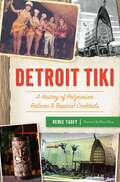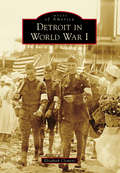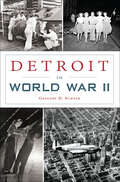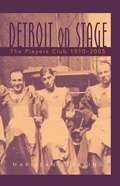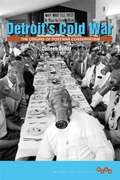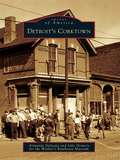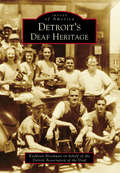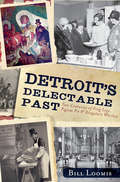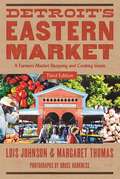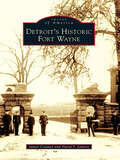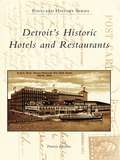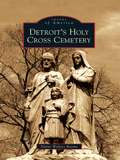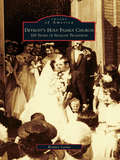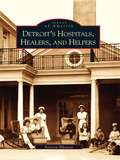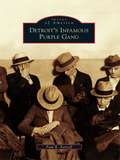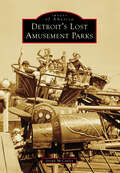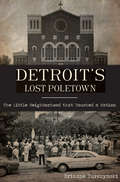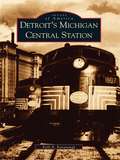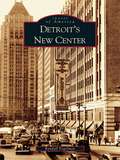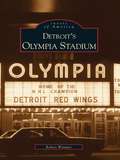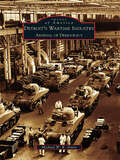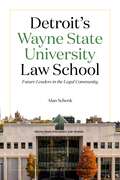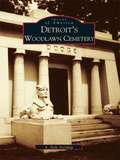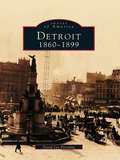- Table View
- List View
Detroit Tiki: A History of Polynesian Palaces & Tropical Cocktails
by Renee TadeyWhen the South Sea craze swept over the nation in the mid-twentieth century, the wave of island-themed décor and tropical cocktails did not pass by Detroit. The Tropics and Club Bali offered a warming escape from dreary Midwest winters. At its completion in 1967, the Mauna Loa was the most expensive restaurant built east of the Mississippi. With its lush interior and celebrity patrons, it did not disappoint. The Chin Tiki, with its exquisitely handcrafted features, was no less an exceptional destination. Even today, long after the Polynesian craze has faded, a new generation has taken up the tiki torch and brought island flavor and flair back to the city. Join author Renee Tadey on a sweeping journey through the tiki destinations of Detroit.
Detroit and the New Political Economy of Integration in Public Education
by Curtis L. Ivery Joshua A. BassettThis edited volume analyzes a little-known but important juncture in the history of racial integration and public education during the Obama administration through the advent of the Trump administration, which also marks a significant transition of US racial politics and race relations from its foundations in civil rights movements of the 1950s/60s. Focusing on the City of Detroit, which via the historic Supreme Court case, Milliken v. Bradley, stands as the central site of analysis for these broader national dynamics of race, education, and integration—what we term as a “new political economy of integration”—this volume offers a multidisciplinary perspective on the critical role integration must play in the project of America becoming a multiracial democracy as US populations continue to grow more diverse and will soon transform the nation into a multiracial majority for the first time in its history.
Detroit in World War I (Images of America)
by Elizabeth ClemensWorld War I was the catalyst that ushered in themes that would define the 20th century: industrialization, urbanization, and the struggle for equality between social classes, gender, and race. During this time, from 1914 to 1918, Detroit was a city rapidly on the rise, with spectacular economic, industrial, and population growth. These were years when some of the city's most beautiful structures were built, when its industry practices became the international standard, and when its population exploded with new, hopeful emigrants from across the globe. The war provided a unifying theme to a city struggling to define itself and caused its people to come together in new and unexpected ways to support the war effort at home and abroad, often stepping into unfamiliar roles outside of societal norms. Detroit in World War I offers a visual exploration of a city and a people caught in a time of dynamic change--from the men who served the cause to the communities they left behind--who rose to the challenge splendidly and helped create one of the 20th century's most remarkable and vibrant cities.
Detroit in World War II
by Gregory D. SumnerA history of everyday life in the Motor City during the Second World War and the contributions its citizens made to the war effort. When President Roosevelt called for the country to be the great &“Arsenal of Democracy,&” Detroit helped turn the tide against fascism with its industrial might. Locals were committed to the cause, putting careers and personal ambitions on hold. Factories were retooled from the ground up. Industrialist Henry Ford, First Lady Eleanor Roosevelt, aviator Charles Lindbergh, legendary boxer Joe Louis, future baseball Hall of Famer Hank Greenberg and the real-life Rosie the Riveters all helped drive the city that was &“forging thunderbolts&” for the front lines. With a panoramic narrative, author Gregory D. Sumner chronicles the wartime sacrifices, contributions and everyday life of the Motor City.
Detroit on Stage: The Players Club, 1910-2005 (Great Lakes Books Series)
by Marijean LeveringFounded in 1910, Detroit’s Players Club is an all-male club devoted to the production of theater by members for other members’ enjoyment. Called simply "The Players," members of the club design, direct, and act in the shows, including playing the female roles. In Detroit on Stage, Marijean Levering takes readers behind the scenes of the club’s private "frolics" to explore the unique history of The Players, discover what traditions they still hold dear, and examine why they have survived relatively unscathed through changes that have shuttered older and more venerable institutions. The Players developed during a nationwide vogue for community and art theater and also as Detroit’s auto elites were in the midst of forming new private clubs to add to their own sense of prestige. By the 1920s, The Players had built their own playhouse and established most of their significant traditions, including the monthly frolics, at which the members perform for each other. At the frolics, members in the audience would wear tuxedos and drink beer out of personalized mugs, customs that remain to this day. Prominent Detroiters have always been among the ranks of the Players, and several well-known auto industry figures were members from the beginning, including banker Henry B. Joy, Oldsmobile sales manager Roy D. Chapin, and Ford executives James Couzens and Edsel Ford. Over the decades that followed the club’s founding, its membership and traditions have remained strong despite major world events that shook Detroit such as Prohibition, the Great Depression, and World War II. In looking at The Players of today, Levering explores the camaraderie and sense of history that has kept the club together and relatively unchanged throughout the years. She also examines the club’s notable members and its unique place in Detroit history. Detroit on Stage places The Players club in the broader contexts of social clubs, explaining how these organizations originate and function. Readers interested in Detroit cultural history and theater studies will enjoy this rare glimpse inside a long-standing Detroit cultural institution.
Detroit's Cold War: The Origins of Postwar Conservatism
by Colleen DoodyDetroit's Cold War locates the roots of American conservatism in a city that was a nexus of labor and industry in postwar America. Drawing on meticulous archival research focusing on Detroit, Colleen Doody shows how conflict over business values and opposition to labor, anticommunism, racial animosity, and religion led to the development of a conservative ethos in the aftermath of World War II. Using Detroit--with its large population of African-American and Catholic immigrant workers, strong union presence, and starkly segregated urban landscape--as a case study, Doody articulates a nuanced understanding of anticommunism during the Red Scare. Looking beyond national politics, she focuses on key debates occurring at the local level among a wide variety of common citizens. In examining this city's social and political fabric, Doody illustrates that domestic anticommunism was a cohesive, multifaceted ideology that arose less from Soviet ideological incursion than from tensions within the American public.
Detroit's Corktown (Images of America)
by Armando Delicato Julie Demery Workman’s Rowhouse MuseumDetroit's Corktown celebrates the history of Detroit's oldest neighborhood. From Irish immigrants in the 1840s to urban pioneers of the 21st century, this community has beckoned to the restless of spirit, the adventurous, and those who have sought to escape poverty and oppression to make a new life in America. While the city of Detroit has undergone tremendous change over the years, Corktown has never forgotten the solid working-class roots established by brave pioneers in the mid-19th century. Many of their shotgun homes are still occupied, and many commercial buildings have served the community for decades. Today the neighborhood is the scene of increasing residential and commercial development and has attracted attention throughout the region. No longer exclusively Irish, the community has also been important historically to the large German, Maltese, and Mexican populations of Detroit. Today it is a diverse and proud community of African Americans, Hispanics, working-class people of various national origins, and a growing population of young urban pioneers. It is still the sentimental heart of the Irish American community of metropolitan Detroit, and the Irish Plaza on Sixth Street honors the city's Irish pioneers and their 600,000 descendents living in the region.
Detroit's Deaf Heritage (Images of America)
by Kathleen Brockway Detroit Association of the DeafDetroit, the Motor City, welcomed many newcomers to work and interact in the deaf community in the early 20th century. The booming job market attracted Benjamin and Ralph Beaver, deaf brothers from Iuka, Illinois, who helped form the Detroit Association of the Deaf (DAD) Club--celebrating its 100th anniversary in 2016. Others included the Wahowiak family, who ran a shoe repair business in Upper Michigan for two deaf generations; Arlyn Meyerson, a deaf restaurateur for 55 years; Glenn Stewart, the first black deaf man graduated from Rochester Institute of Technology; and Dudley Cutshaw, a longtime deaf local leader. In addition, Grand Rapids, Flint, and Upper Michigan each contributed to this great deaf heritage by affiliating with Detroit's deaf community. Through vintage photographs of successful organizations, including Catholic Deaf Organization, Motor City Association of the Deaf, Black Silent Club, Michigan Deaf School, and Flint Association for the Deaf, Detroit's Deaf Heritage illustrates the evolution of the deaf community and its prominent leaders.
Detroit's Delectable Past: Two Centuries of Frog Legs, Pigeon Pie and Drugstore Whiskey (American Palate)
by Bill LoomisJoin local food aficionado Bill Loomis on a look back at the appetites, tastes, kitchens, parties, holidays and everyday meals that defined eating in Detroit, from the earliest days as a French village to the start of the twentieth century. Whether it's at a frontier farmers' market, a Victorian twelve-course children's birthday party replete with tongue sandwiches or a five-cent-lunch diner, food is a main ingredient in a community's identity and history. While showcasing favorite fare of the day, this book also explores historic foodways--how locals fished the Detroit River, banished flies from kitchens without screens and harvested frog legs with miniscule shotguns. Wedding feasts, pioneer grub, cooking classes and the thriftless '20s are all on the menu, too.
Detroit's Eastern Market: A Farmers Market Shopping and Cooking Guide, Third Edition (Painted Turtle)
by Bruce Harkness Lois Johnson Margaret ThomasSince 1887, Detroit’s Eastern Market, the largest open-air market of its kind in the United States, has been home to an amazing community of farmers, merchants, and food lovers. Specialty shops, bakeries, spice companies, meat and poultry markets, restaurants, jazz cafés, old-time saloons, produce firms, gourmet shops, and cold-storage warehouses cover Eastern Market’s three square miles. Its many streets and vendors reflect the varied cultures and ethnicities that have shaped the city of Detroit. In this third edition of Detroit’s Eastern Market, authors Lois Johnson and Margaret Thomas recount the history of the market with additional stories and personal accounts of families who have worked and shopped there for as many as four generations. The authors have updated store information and added new restaurants and businesses to their original listings, reflecting the changes and additions that have taken place in Eastern Market since the previous edition in 2005. Richly illustrated with all new photos, Detroit’s Eastern Market features more than a hundred pages of delightful recipes (including 17 new ones) from market retailers, farmers, chefs, and customers.
Detroit's Historic Fort Wayne (Images of America)
by James Conway David F. JamrozMichigan's historic Fort Wayne, located on the narrowest point of the Detroit River, is named for Revolutionary War hero Gen. "Mad" Anthony Wayne. The fort was built in the 1840s to protect Detroit from British invasion following the strife of the 1838 Patriot War in Canada. Originally constructed of earth and wood, the fortifications were rebuilt in masonry during the Civil War, but the fort has never mounted cannons, as peace came to the international border and remains to this day. Fort Wayne has served the military as a training center, home to infantry regiments, supply depot, prisoner of war camp, and major induction center. It was a source of work for the unemployed during the Great Depression, a place of confinement during the Red Scare of 1920, and home for those displaced by civil unrest in Detroit during the 1960s. The fort continues to invite people to its riverfront view, not as soldiers but as guests, to enjoy community events on its broad parade fields and to learn about those who lived, drilled, and worked there.
Detroit's Historic Hotels and Restaurants (Postcard History Series)
by Patricia IbbotsonDetroit's population grew rapidly after the beginning of the 20th century due to the growth of the automobile and other industries, and the city became a tourist and convention center. Detroit was in its heyday in the 1920s when it was the fourth-largest city in the United States. Some of Detroit's larger hotels were architectural masterpieces, nationally known, and were the center of socialactivities. Others were lesser-known second-class hotels now largely forgotten. Detroit restaurants ranged from the self-serve to the elegant. These hotels and restaurants, many of which are gone now, are preserved in nearly 200 vintage postcards, allowing the reader to take a trip down memory lane.
Detroit's Holy Cross Cemetery (Images of America)
by Elaine Walters RaymoIn the early hours before dawn on October 6, 1907, a raging fire illuminated the sky as the historic chapel that stood on the cemetery grounds for over half a century reduced to a pile of cinders and ash. Lit by sparks from a nearby barn ablaze from an act of arson, the fire destroyed priceless paintings, relics, statues, and artifacts that held sacrament to the area's earliest settlers. So ended the era of the cemetery's obscure past and launched a new era for the little mission?turned?graveyard nestled southwest of Detroit. Detroit's Holy Cross Cemetery is a collage of persons whose immigrant dreams landed them in an area budding with industry. The cemetery's evolution reflects the waves of immigration, from the early French to the Irish, Germans, Hungarians, Poles, and Hispanics. From its 1838 2-acre roots to its current 65-acre span, Holy Cross Cemetery filled the need for a Catholic cemetery on Detroit's west side.
Detroit's Holy Family Church: 100 Years of Sicilian Tradition (Images of America)
by Bonnie LeoneA treasury of photos and stories celebrating this historic landmark and Detroit&’s Italian-American community. The traditions of the Sicilians and Italians have been a part of Detroit since the early 1900s, and Holy Family Church represents the very root of this community&’s soul, maintaining the culture and the rituals their ancestors brought with them to America over a century ago. Some of these customs date back hundreds of years in their homelands of Cinisi, Terrasini, Trapani, and many other cities. Bonnie Leone was born, raised, and still resides in Detroit. Originally appointed by Gov. John Engler to the position of Wayne County jury commissioner, Leone is a member of several genealogical societies, tracing some of her ancestors as far back as the 1500s. Her strong sense of history, art, and tradition brought her to this church, so that she may help to preserve and protect the traditions of the Sicilians in Detroit—and in this richly illustrated book, she shares its story.
Detroit's Hospitals, Healers, and Helpers
by Patricia IbbotsonThe modern hospital evolved from both military garrisons and poorhouses. It wasn't until the mid-19th century that facilities with a wider purpose were founded in Detroit to combat diseases like cholera, tuberculosis, and mental illness. Religious institutions and benevolent societies established homes and treatment centers for the ill and abandoned, while public institutions were created for the very first time. This fascinating pictorial history of health care in the Detroit area features over 200 photographs and postcards of early hospitals, sanitariums, and orphanages, and the kindhearted people who staffed them. From St. Mary's, founded in 1845 and later known as Detroit Memorial Hospital, to Henry Ford Hospital, founded in 1915, this book documents the variety of institutions that sought to relieve or cure medical conditions. Most of these historic facilities no longer exist, and are known only by the photographs that preserve them. The images provide a rare glimpse of what health care was like at the turn of the century.
Detroit's Infamous Purple Gang (Images of America)
by Paul R. KavieffDetroit's Infamous Purple Gang is a photographic history of one of the most notorious organized crime groups of the 20th century. The photographs chronologically follow the evolution of the Purples from their days as a juvenile street gang through their rise to power and eventual self-destruction. Using rare police department mug shots and group photographs, the book transports readers through the dark side of Prohibition-era Detroit history. Detroit had a gold rush atmosphere and a thriving black market during the 1920s that attracted gangsters and unsavory characters from all over the country.
Detroit's Lost Amusement Parks (Images of America)
by Joseph McCauleyArthur Gaulker, a successful real estate scion, gathered investors to create Electric Amusement Park in 1906. Gaulker's park was located near the Belle Isle Bridge just a few miles from downtown Detroit. Morris Wolff opened his Wolff's Park in 1906 directly across the street from Electric Park. Both parks spent lavishly and went bankrupt within a few years; however, other parks replaced them. By 1927, city officials had grown tired of the noise and widespread gambling, so they closed down the parks. Eastwood Park, Jefferson Beach Amusement Park, Edgewater Park, Walled Lake Park, and Bob Lo Park filled the void for years. Big bands got the parks through the Depression, multiple wars, and an onslaught of televised entertainment. However, costly fires, local opposition, and corporate competition became too much for the local parks, most of which were family-owned. Bob Lo Park, which closed in 1993, was the last to go out of business.
Detroit's Lost Poletown: The Little Neighborhood That Touched a Nation
by Brianne TurczynskiPoletown was a once vibrant, ethnically diverse neighborhood in Detroit. In its prime, it had a store on every corner. Its theaters, restaurants and schools thrived, and its churches catered to a multiplicity of denominations. In 1981, General Motors announced plans for a new plant in Detroit and pointed to the 465 acres of Poletown. Using the law of eminent domain with a quick-take clause, the city planned to relocate 4,200 residents within ten months and raze the neighborhood. With unprecedented defiance, the residents fought back in vain. In 2004, the Michigan Supreme Court ruled that the eminent domain law applied to Poletown was unconstitutional--a ruling that came two decades too late.
Detroit's Michigan Central Station (Images of America)
by Kelli B. KavanaughIn 1913, the Michigan Central Station opened its majestic entrances to the people of Detroit. Designed by Warren & Wetmore and Reed & Stern, the firms also noted as the architects of the Grand Central Station in New York City, the depot was a marvel of grandeur and comfort for the traveler lucky enough to utilize its facilities. Soldiers went to war, families both separated and rejoined, and folks looking for an honest living in the Motor City all walked the Michigan Central's elegant corridors. Since the last train pulled away from the station in 1988, the structure has fallen prey to rapidly paced deterioration. Detroit's Michigan Central Station captures the glory of the Michigan Central and its environs. Using photographs from the Burton Historical Collection, as well as private collections, the book illustrates the use of the Michigan Central Station by a city whose story dramatically parallels that of this magnificent structure. The book also includes imagined futures of the station from some of the many people who have been inspired by the magic this grand building continues to exude.
Detroit's New Center (Images of America)
by Randall FogelmanThe northern anchor of Detroit's greater downtown, New Center is a diverse and vibrant neighborhood that offers shopping, entertainment, and dining among landmark architecture, historic districts, and contemporary homes and businesses. Shortly after General Motors built their headquarters three miles north of downtown, the Fisher Brothers conceived the idea of a "new center" and proceeded to construct the landmark Fisher and New Center Buildings. From this initial activity in the 1920s sprung a new commercial district, a new neighborhood, and a New Center for the City of Detroit. Detroit's New Center takes readers on a journey from New Center's origins as a planned business district to its current life as a thriving area where Detroiters live, work, and play.
Detroit's Olympia Stadium
by Robert WimmerAlso known as the Old Red Barn, Olympia Stadium was the largest rink in the United States when it opened in Detroit on October 22,1927. Robert Wimmer has compiled over 200 historic photographs and detailed captions for this new book, that follows the life of a sporting and entertainment landmark in the Motor City until its demolition in 1986. For over half a century, the Olympia Stadium hosted many of the top shows and stars coming through Detroit. The historic landmark filled its seats for the multitude of sporting events in Michigan, including championship boxing, wrestling, and lacrosse, and was also the home of the Detroit Redwings and the Pistons. Although there are many anonymous people pictured here who contributed to the history of the stadium, readers will recognize the more familiar faces and acts of Elvis Presley, the Beatles, the Roy Rogers Rodeo, Dick the Bruiser, and many others.
Detroit's Wartime Industry: Arsenal of Democracy (Images of America)
by Michael W. DavisJust as Detroit symbolizes the U.S. automobile industry, during World War II it also came to stand for all American industry's conversion from civilian goods to war material. The label "Arsenal of Democracy" was coined by Pres. Franklin D. Roosevelt in a fireside chat radio broadcast on December 29, 1940, nearly a year before the United States formally entered the war. Here is the pictorial story of one Detroiter's unique leadership in the miraculous speed Detroit's mass-production capacity was shifted to output of tanks, trucks, guns, and airplanes to support America's victory and of the struggles of civilians on the home front.
Detroit's Wayne State University Law School: Future Leaders in the Legal Community (Great Lakes Books Series)
by Alan SchenkMost histories of law schools focus on the notable deans and professors, and the changes in curricula over time. In Detroit’s Wayne State University Law School: Future Leaders in the Legal Community, Alan Schenk highlights the students and their influence on the school’s development, character, and employment opportunities. Detroit’s Wayne State University Law School begins by placing the school in historical context. Public law schools in major American cities were rare in the 1920s. WSU Law School started as a night-only school on the brink of the Great Depression. It was administered by the Detroit Board of Education’s Colleges of the City of Detroit and was minimally funded out of student tuition and fees. From its opening days, the school admitted students who had the required college credits, without regard to their gender, race, or ethnic backgrounds, when many law schools restricted or denied admission to women, people of color, and Jewish applicants. The school maintained its steadfast commitment to a racially and gender-diverse student body, though it endured significant challenges along the way. Denied employment at selective law firms and relegated to providing basic legal services, WSU law students pressed the school to expand the curriculum and establish programs that provided them with the credentials afforded graduates from elite law schools. It took the persistence of the students and a persuasive dean to change the conversation about the quality of the graduates and for law firms representing the largest corporations and wealthiest individuals to start hiring WSU graduates who now heavily populate those firms. In the twenty-first century, the school gained strength in international legal studies and established two law centers that reflect the institution’s longstanding commitment to public interest and civil rights. While much of the material was gathered from university and law school archives, valuable information was derived from the author’s recorded interviews with alumni, deans, and professors. This book will strike the hearts of WSU law school students and alumni, as well as those interested in urban legal education and history.
Detroit's Woodlawn Cemetery
by A. Dale NorthupA repository of community memory, exquisite architectural structures, and lasting tributes to the departed, Woodlawn Cemetery serves as a testament to Detroit's multi-faceted history. Considered by many as an outdoor museum of Detroit's architectural, economic, social, and cultural vitality, Woodlawn is the final resting place of the Dodge Brothers, Edsel and Eleanor Ford, Hazen Pingree, and James Couzens, along with countless other historic figures. Through a rare collection of photographs, this book serves as a guided tour along the paths of Woodlawn, from the work of noteworthy architects and sculptors to the legacies of the extraordinary people who have shaped Detroit history.
Detroit: 1860-1899 (Images of America)
by David Lee PorembaIn this rare and unprecedented collection, discover Detroit as it once was, with the people and industries that flourished in this community prior to the twentieth century. With over 230 photographs, Detroit 1860-1899 encompasses a visual history of the city before the birth of the automobile industry. Join Mr. Poremba on a trip down memory lane to the beginnings of the "Motor City." Witness its growth and change, and its lasting contributions to our nation's history. Detroit 1860-1899 will be enjoyed by young and old, resident and visitor alike.
